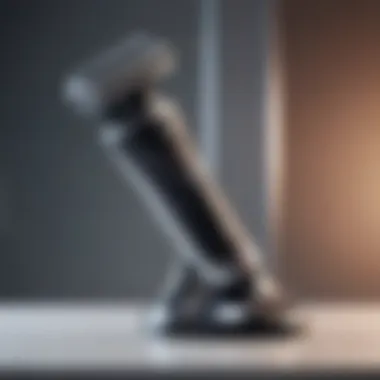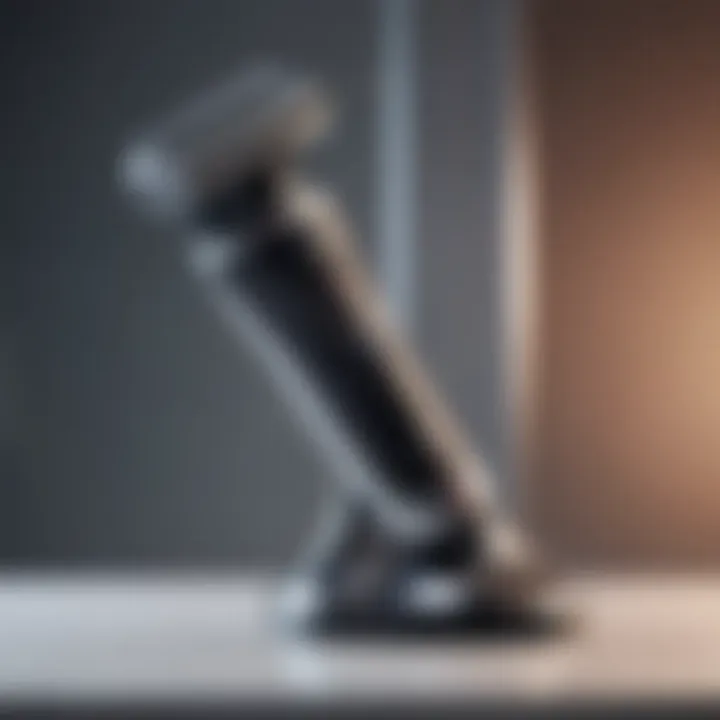Wet Shave vs. Electric Razors: A Detailed Comparison


Intro
The choice between wet shaving and electric razors is significant for many women seeking to refine their personal grooming routines. Each method presents distinct attributes that resonate differently with individual preferences and needs. Understanding these dynamics can empower you to make a well-informed choice that aligns with your lifestyle. Factors such as convenience, safety, skin sensitivity, and efficacy play essential roles in this decision-making process. This article will navigate the intricacies of both shaving techniques, allowing you to weigh the pros and cons effectively.
Fashion Trends
While personal grooming is crucial, it often intertwines with current fashion trends. Maintaining smooth, well-groomed skin is an aspect of self-expression and style that is essential in today’s aesthetic landscape. With the rise of social media and influencer culture, aesthetics are always evolving.
Seasonal Styles
For instance, during the spring and summer months, people tend to favor lighter clothing, making body hair removal a priority. This shift often drives women to consider the most efficient shaving methods available to achieve flawless skin, whether preparing for a beach trip or simply wearing shorter dresses. Many favor wet shaving for its perceived thoroughness and skin-nurturing benefits, especially during warmer seasons when skin is exposed more.
Influencer Inspirations
Influencers also play a role in shaping preferences around shaving techniques. A single tutorial can spark interest in alternative methods. Influencers often showcase their routines, which can highlight products or techniques—wet shaving or electric—to their audience. This can create a significant impact, leading women to explore options they may not have considered otherwise.
Beauty Tips
Beyond the shaving methods themselves, it is vital to understand how these techniques fit into your broader beauty regimen.
Skincare Routines
Incorporating effective skincare routines alongside your shaving method is key for maintaining healthy skin. A thorough exfoliation prior to either method encourages a better shave and minimizes irritation. For wet shaving, using a quality shaving cream or gel can provide a smoother glide and additional protection for the skin. Conversely, electric razors may require different preparation such as ensuring the skin is dry and clean to enhance efficacy.
Makeup Techniques
The decision on how to groom can also influence makeup application. Flawless skin enhances the overall look and allows makeup to sit evenly. Notably, if you choose wet shaving, applying makeup shortly after might require waiting for any tiny nicks to heal. Electric razors typically minimize irritations, promoting a quicker transition to makeup application.
Product Reviews
Product selection is another critical factor in this discussion. The market has a wide array of options catered to different preferences and skin types. Evaluating products based on personal needs will significantly impact your shaving experience.
Trending Products
From high-end wet shavers like the Gillette Venus line to popular electric options such as the Braun Silk-épil series, each product offers unique benefits. Consumers should consider reviews and recommendations, as well as their own skin sensitivity when choosing a product.
Comparison Guides
Furthermore, comparison guides can provide invaluable insights. Assessing aspects such as ease of use, price points, and safety features can reveal which method aligns better with your routine. An organized comparison is essential to empower your personal choices when it comes to grooming.
"Understanding the different shaving methods can pave the way for improved confidence and personal care."
Understanding the Basics of Shaving
Understanding the basics of shaving is essential for anyone interested in personal grooming practices. This foundational knowledge sets the stage for informed choices that cater to individual needs. It involves knowing the different shaving methods available, as well as their distinct characteristics.
Proper understanding helps in achieving better results while minimizing discomfort or skin issues.
In this article, we will explore two primary shaving techniques: wet shaving and electric shaving. Each has its own set of benefits and considerations, making it crucial to understand what each entails. This knowledge can empower readers to make decisions that align with their preferences concerning convenience, effectiveness, and skin sensitivity.
What is Wet Shaving?
Wet shaving is a traditional method of shaving that involves the use of water, shaving cream, or soap. The process typically includes using a razor blade—either a safety razor or a straight razor. Wet shaving emphasizes a close shave, which many users find satisfying.
The technique often requires preparation, such as softening the hair with warm water and applying a quality shaving cream. This not only enhances the shaving experience but also helps to protect the skin, reducing the risk of irritation and razor burns. Therefore, wet shaving can be preferable for individuals seeking a thorough and smooth finish.
The tools needed include:
- A sharp razor
- Shaving cream or gel
- A brush (optional, but helps lather the cream)
Many enthusiasts appreciate the ritual aspect of wet shaving. There is a certain satisfaction that comes from using high-quality products and techniques tailored to one's skin.
What is Electric Shaving?
Electric shaving employs an electric razor as the primary tool. This method is notable for its convenience. Electric razors can provide a quick solution for those with a busy lifestyle. They often feature various safety mechanisms that help prevent cuts and nicks, making them a safer option for many.
Electric shavers can come in two main types: foil razors and rotary razors. Each type manages hair removal differently, which can affect the shave quality and skin comfort. However, many users report that while electric shaves are less likely to cause cuts, they may not provide the same closeness as wet shaving.
Key features of electric shaving include:
- Quick and easy use
- Reusable with less frequent need for new products
- Greater mobility for those on the go


Historical Context of Shaving Techniques
Understanding the historical context of shaving techniques allows readers to appreciate the evolution of personal grooming practices. It highlights how societal norms, advancements in technology, and evolving standards of beauty have shaped the way women perceive shaving. Furthermore, this context is essential in guiding modern choices in shaving methods, encouraging informed decision-making based on individual values and preferences.
Evolution of Wet Shaving
Wet shaving has roots tracing back to ancient civilizations. The earliest known instruments were made of sharpened stones or shells. In ancient Egypt, razors commonly comprised bronze. These rudimentary tools represented a critical step toward the refinement of shaving techniques. As civilizations progressed, materials improved. The introduction of safety razors in the early 20th century revolutionized the wet shaving experience.
With the development of high-quality blades and shaving creams, users found that this method provided a close shave while allowing for greater control. Wet shaving techniques further evolved with the introduction of modern products. Incorporating lubricating oils and sophisticated creams has enhanced the experience, especially for those with sensitive skin.
Moreover, wet shaving has cultural significance in many societies. It often embodies rituals of personal care and self-respect, contributing to a more engaged grooming experience. Users often cite the ritualistic nature as a means to connect with themselves, focusing on the process rather than the outcome. In essence, wet shaving offers more than just hair removal; it provides a holistic experience rooted deeply in history.
The Rise of Electric Razors
The introduction and rise of electric razors marked a significant turning point in grooming. First invented in the early 20th century, electric razors gained popularity in the 1930s with the advent of motorized options. These devices promised convenience to users, particularly appealing to women who balanced busy lifestyles.
Electric razors eliminated many of the challenges associated with wet shaving, such as preparing the skin and cleaning up afterward. Some electric models offered features like adjustable heads, which contributed to a more customized experience. Brands like Philips and Braun became front-runners in electric grooming, continuously innovating their products.
However, the success of electric razors comes with trade-offs. While they may provide speed and ease, users often report a less close shave than with traditional methods. This discrepancy can influence women’s choices regarding their preferred grooming methods.
The rise of electric razors also advanced the conversation surrounding grooming practices. As more women began using these devices, discussions about skin sensitivity and suitable products emerged. Thus, the evolution of each technique reflects broader changes in societal beauty standards and personal preferences, drawing a clear line from historical practices to contemporary choices.
Comparative Analysis of Shaving Methods
The analysis of shaving methods, wet shaving and electric shaving, is crucial for understanding their roles in personal grooming. Each technique has distinct advantages and challenges. By evaluating these methods, readers can make informed choices regarding their shaving routines. This section delves deeper into the pros and cons of both methods, highlighting key factors like cost, effectiveness, and potential irritations.
Pros of Wet Shaving
Closeness of Shave
One of the main benefits of wet shaving is the closeness of shave it provides. Using traditional razors, like safety or straight razors, allows for a more thorough cut. The angle of the blade can be adjusted easily, providing a closer finish to the skin. This results in smooth skin, which many users prefer. Fans of wet shaving often prioritize the feeling of a close shave, enhancing their overall grooming experience. However, achieving this closeness may require more skill and practice.
Lower Cost of Tools
Another significant advantage of wet shaving is the lower cost of tools involved. Traditional razors often have lower upfront costs compared to electric razors. Users can find safety razors and blades at various price points, making them accessible for most budgets. Additionally, other essential tools like brushes and creams are also available at reasonable prices. This affordability can make wet shaving an attractive choice for those looking to save money in the long run.
Cons of Wet Shaving
Time Consumption
Wet shaving can be time-consuming, which may deter some individuals. Preparing the skin, applying cream, and going through the shaving process requires more dedication than using an electric razor. For those with tight schedules, this method might not be the most practical. However, many enthusiasts argue that the ritual of wet shaving is relaxing and can serve as a moment of self-care, adding value despite the time investment.
Potential for Cuts and Irritation
One notable downside is the potential for cuts and irritation associated with wet shaving. The blade's contact with the skin can lead to nicks if not used carefully. Those with sensitive skin may also experience redness or razor burn. While many products aim to mitigate these issues, the possibility remains a concern for some users. This risk may push individuals towards electric shaving, where safety features often minimize such problems.
Pros of Electric Razors
Convenience
Electric razors stand out for their convenience. They generally require less preparation time and can be used quickly in various settings. Many models are designed for both wet and dry use, making them versatile. This adaptability is especially useful for individuals who travel or have unpredictable schedules. The simplicity of the shaving process with electric razors makes them a favored choice for many busy professionals.
Safety Features
Safety features in electric razors significantly reduce the chances of cuts and irritation. Many electric models are designed to prevent direct skin contact with blades, which minimizes the risk of injury during use. This characteristic appeals to novice users who may lack experience and those with sensitive skin. The overall design leads to a more comfortable shaving session, making electric razors a safer alternative for many individuals.
Cons of Electric Razors
Cost of Purchase
The cost of electric razors can be a considerable drawback. Compared to traditional razors, the initial investment is often much higher. Quality electric shavers may represent a significant expenditure, making them less accessible for some. Additionally, the ongoing cost of replacement parts like blades may accumulate over time. For some, this expense can overshadow the convenience benefits, making it a critical consideration in their decision-making process.
Less Close Shave
A common critique of electric razors is that they typically provide a less close shave compared to manual razors. The design and mechanics of electric shaving often do not align with the precision of a blade. Consequently, users may not achieve the same level of smoothness they desire. This aspect is particularly important for those who prioritize a clean shave. While electric razors present convenience, they may fall short in delivering the ultimate shaving quality for some users.
Skin Sensitivity and Shaving Techniques
Skin sensitivity plays a critical role in choosing the right shaving method. Different skin types react uniquely to various shaving techniques and products. Awareness of skin sensitivity can greatly improve the shaving experience, making it smoother and less irritating. For many individuals, the goal is to achieve a clean shave while minimizing discomfort. Thus, understanding one's skin type and the best practices tailored to it is essential.
Identifying Skin Types
Recognizing specific skin types is the first step toward effective shaving. Common skin types include normal, oily, dry, and sensitive skin. Each type can respond differently to both wet and electric shaving approaches.


- Normal skin: Generally tolerates various products and techniques.
- Oily skin: May require lightweight products to prevent clogged pores.
- Dry skin: Benefits from moisturizers to avoid irritation.
- Sensitive skin: Prone to redness and irritation; requires the most care in product choice and shaving technique.
Understanding your skin's characteristics enables a more personalized and effective shaving regimen.
Best Practices for Sensitive Skin
Choosing the Right Products
When it comes to sensitive skin, selecting appropriate shaving products is vital. Products specifically designed for sensitive skin—indicated by terms such as "hypoallergenic" or "fragrance-free"—tend to offer a gentler option. Key characteristics of these products include minimal irritation and enhanced moisturizing properties. This makes them suitable for reducing post-shave discomfort.
Moreover, the unique feature of choosing the right products is their formulation. Ingredients like aloe vera and chamomile can calm the skin. The advantage of utilizing these products lies in their ability to soothe rather than agitate sensitive skin, making daily shaving feasible without painful consequences.
Shaving Techniques
Shaving techniques should also be considered for sensitive skin. A gentler approach is paramount—shaving in the direction of hair growth can minimize irritation. Key characteristics of effective shaving techniques often include short strokes and light pressure. This reduces the risk of cuts and enhances comfort during the process.
The unique aspect of proper shaving techniques is the blend of speed and precision. While a quick shave may seem convenient, it's essential to prioritize technique to protect sensitive skin. Utilizing this careful method can greatly decrease incidents of skin irritation and enhance the overall shaving experience.
Product Selection for Optimal Performance
Selecting the right shaving tools is crucial for achieving optimal results. The right choice can minimize skin irritation and enhance overall shave quality. Understanding various options allows individuals to tailor their grooming routine to their specific needs. Whether opting for wet shaving or electric razors, knowing the strengths and weaknesses of each product helps in making informed decisions.
It’s essential to consider factors such as skin type, hair texture, and personal preferences. Proper product selection not only affects effectiveness but also impacts comfort during and after shaving. Lastly, investing in reliable products can lead to long-term savings, as quality tools often last longer and perform better.
Best Razors for Wet Shaving
Safety Razors
Safety razors have gained popularity among many users due to their design, which significantly reduces the risk of cuts compared to traditional straight razors. The key characteristic of safety razors is their protective guard, which helps keep the blade from coming into direct contact with the skin. This feature is particularly beneficial for those new to wet shaving or those with sensitive skin.
One unique aspect of safety razors is their versatility; they allow users to choose from a variety of blades that can cater to different hair types and thicknesses. However, while they often provide a closer shave than many cartridge razors, there is a learning curve involved. Users must develop a precise technique to maximize their effectiveness and minimize irritation.
Straight Razors
Straight razors remain a choice for enthusiasts who appreciate the precision they offer. The defining characteristic of a straight razor is its single, long blade. This design allows for an exceptionally close shave and more control over the shaving angle. They are considered a sustainable option since they can last a lifetime with proper maintenance.
A unique feature of straight razors is the need for honing and stropping to maintain a sharp edge. While this requires some effort, many find the ritual rewarding. However, the main disadvantage lies in the risk of cuts, particularly for beginners. Using a straight razor can also be time-consuming, making it less practical for those with busy schedules.
Top Electric Razor Models
Foil Razors
Foil razors are designed with a thin layer of foil covering the blades, providing a protective barrier that minimizes the risk of skin irritation. Their key characteristic is the straight oscillating blades that work between the foil and skin. This design is preferred by users with sensitive skin or those who favor a close, smooth finish.
One unique advantage of foil razors is their efficiency in capturing hair, making for a quicker shave. However, they may not be as effective on longer hair, and some users may find them less comfortable on the neck or jawline areas.
Rotary Razors
Rotary razors feature rotating heads, which can move and adjust to the contours of the face. This design makes them a popular choice for those with fuller facial hair or varying hair lengths. The key benefit is their flexibility, which allows for comfortable shaving over uneven skin surfaces.
A distinguishing factor of rotary razors is their ability to cut hair growing in different directions. This can lead to a quicker overall shave, especially for individuals who have a busy lifestyle. However, they might not provide as close a shave as foil razors, which could be a consideration for those seeking maximum smoothness.
Shaving Accessories Review
In the realm of personal grooming, the tools utilized can significantly impact the overall effectiveness and experience of shaving. Understanding and selecting the right accessories is crucial for achieving optimal results, whether choosing wet shaving or electric razors. This section will examine various shaving accessories that enhance the shaving process. We will explore the quintessential products like creams, gels, and aftershave items that further contribute to skin care.
Shaving Creams and Gels
Shaving creams and gels are essential in creating a smooth and protective barrier between the skin and the razor. They help in softening hair follicles, which can make the shaving process less abrasive. Furthermore, they are an integral part of a proper wet shave routine. These products can typically be categorized into two main types: creams and gels.
Benefits of Using Shaving Creams:
- Hydration: Creams provide moisture to the skin, helping to prevent irritation and dryness.
- Thicker Texture: They usually create a rich lather, allowing for a closer shave by lifting the hair.
- Variety of Formulations: Many shampo creams cater to different skin types, including sensitive skin options.
On the other hand, gels generally have a lighter texture and can be more suitable for those who prefer a wetter application. Some of the benefits of shaving gels include:
- Clarity: Gels tend to be transparent, allowing you to see the areas you are shaving better.
- Cooling Sensation: Certain gels contain menthol or other cooling agents, which can provide a refreshing effect.
Choosing the right product involves not just personal preference but also consideration of skin type and sensitivity. Brands such as Proraso and Nivea offer a range of options that can cater to diverse needs.
Aftershave Products


Aftercare is a vital component of any shaving routine. Once the shaving action is complete, applying aftershave products can help soothe, hydrate, and protect the skin. This step becomes even more significant for those who use wet shaving methods, as the skin may be more vulnerable.
There are several types of aftershave products, including balms, lotions, and splash products. Each serves a unique purpose:
- Balms are usually thicker and contain moisturizers that can help heal and rehydrate the skin. These are often preferred by individuals with dry or sensitive skin.
- Lotions tend to be lighter and absorb quickly, suitable for those who prefer a less greasy feel.
- Splash products deliver a refreshing burst, often containing alcohol, which can sterilize any small cuts while offering a cooling sensation. However, caution is advised for sensitive skin types as they can lead to irritation.
It’s important to read labels for key ingredients like aloe vera, witch hazel, and glycerin, which are known for their soothing properties.
Aftershave products are not just about smell; they play an important role in ensuring skin health post-shave.
The Environmental Impact of Shaving Choices
Shaving choices extend beyond individual preference; they also encompass broader environmental considerations. As awareness of sustainability grows, so does the need to examine the ecological footprint of grooming methods, particularly wet shaving and electric razors. This section highlights some significant factors surrounding the environmental impact of these shaving techniques, enabling consumers to make better-informed decisions that align with their values.
Sustainability in Wet Shaving
Wet shaving has gained a reputation for being more environmentally conscious compared to electric shaving. One key element contributing to its sustainability is the use of traditional, reusable tools like safety razors and straight razors. Unlike disposable plastic razors, these products have longer lifespans, thus minimizing waste generation. The blades used in these razors can also be recycled, further reducing their environmental impact.
Choosing natural shaving creams and soaps can enhance the eco-friendliness of wet shaving as well. These products tend to come in recyclable or biodegradable packaging, decreasing plastic waste.
Here are some benefits of adopting wet shaving:
- Less plastic waste: Fewer disposable razors contribute to less pollution.
- Long-lasting tools: Quality razors can last for years if properly maintained.
- Natural ingredients: Sustainable brands often utilize organic materials.
Eco-Friendly Electric Razors
Electric razors also have a role to play in sustainability. Certain brands focus on manufacturing eco-friendly electric razors that meet higher production standards and utilize sustainable materials. For instance, some models use recyclable components, minimizing their environmental footprint. Furthermore, electric razors promote energy efficiency in personal grooming.
When assessing electric razors for sustainability, consider the following aspects:
- Energy-efficient technology: Look for models that consume less power.
- Durability: High-quality electric razors can last many years, reducing the need for replacements.
- Recyclability: Confirm if parts can be recycled when the device reaches its end of life.
"The choice between wet shaving and electric razors may reflect personal values, including a commitment to sustainability and environmental protection."
By evaluating environmental impacts, individuals can better understand how their choices affect the planet. Making informed decisions is essential for aligning personal grooming habits with sustainable practices.
Practical Tips for Effective Shaving
Effective shaving is critical for both comfort and appearance. Whether one chooses wet shaving or electric razors, preparation and technique play a massive role in the quality of the shave. This section will highlight practical advice tailored for both methods.
Preparation and Technique for Wet Shaving
Wet shaving requires a unique set of preparations and techniques to achieve optimal results. First and foremost, investing in quality tools can significantly enhance the experience. Items like a good quality razor, a badger brush, and high-grade shaving cream or soap make all the difference.
Here are key steps to consider:
- Hydrate the Skin: Before starting, it is vital to hydrate the skin using warm water. This helps to soften hair and opens up pores, making hair removal smoother.
- Use a Pre-Shave Oil: Applying a light layer of pre-shave oil can create a barrier. This will protect the skin from nicks and enhance glide during shaving.
- Shaving with the Grain: When you start shaving, move the razor in the direction of hair growth, known as shaving with the grain. This technique minimizes irritation and reduces the risk of ingrown hairs.
- Rinse the Blade Frequently: To maintain effectiveness, rinse the razor blade with warm water regularly while shaving. This helps clear away hair and buildup, ensuring a cleaner cut.
- Post-Shave Rinse: Once finished, rinse the skin with cold water to close the pores. This aids in reducing irritation and redness.
Effective Use of Electric Razors
Using an electric razor has its own distinct advantages and best practices. Since this method generally offers convenience, understanding how to use the device efficiently can maximize its benefits.
Consider the following guidelines:
- Charge the Razor Fully: Ensure that the electric razor is fully charged before use. A good battery guarantees consistent performance and avoids interruptions during shaving.
- Clean and Prepare the Skin: Like wet shaving, preparing the skin matters. Cleanse the area beforehand for optimal results.
- Adjust the Settings: Many electric razors come with adjustable settings for different hair lengths or skin types. Use the appropriate setting for better comfort and effectiveness.
- Technique Matters: Move the electric razor in circular motions or linear strokes, depending on the design. Be gentle, but firm—excess pressure may lead to irritation.
- Regular Maintenance: After finishing the shave, clean the electric razor according to the manufacturer’s instructions. Keeping the blades sharp and clear of buildup ensures longevity and performance.
Effective preparation and proper techniques in both methods can greatly enhance the quality of the shave and minimize skin irritations.
Post-Shave Care and Maintenance
Post-shave care and maintenance are crucial for healthy skin and optimal shaving performance. It is essential to take the time to address the skin's needs after shaving, whether using wet shaving or electric razors. Proper aftercare reduces irritation, hydrates the skin, and helps maintain the effectiveness of the grooming tools. Many women overlook this step, assuming that the shave is complete once they finish. However, neglecting post-shave care can lead to issues like dryness, inflammation, and even breakouts.
With wet shaving, the skin experiences a lot of friction and exposure, making it vital to soothe and nourish it afterward. For electric shaving, maintaining the tool in good condition keeps it functioning effectively and hygienically. Thus, understanding the nuances of post-shave care is beneficial for anyone looking to enhance their grooming routine.
Aftercare for Wet Shaving
Following a wet shave, the skin requires carefully formulated aftercare. Here are key steps worth considering:
- Cleanse the Skin: After shaving, the first step is to rinse the skin with cool water. This helps close pores and reduces any redness or irritation.
- Moisturizing: Applying a nourishing moisturizer is essential. Look for products that contain vitamin E or aloe vera. These ingredients help soothe and hydrate the skin.
- Aftershave Balms: For wet shavers, using an aftershave balm can significantly reduce irritation. Choose a balm that is alcohol-free as alcohol can worsen dryness and sensitivity.
- Exfoliation: Regular exfoliation can help prevent ingrown hairs. Consider a gentle scrub once or twice a week, ensuring it is suitable for sensitive skin.
- Hydration: Drinking water is another good practice. Staying well-hydrated aids skin recovery and overall health.
Maintaining Electric Razors
Unlike wet shaving, maintaining electric razors involves understanding the components of the device for longevity and optimal performance. Here are practical tips:
- Regular Cleaning: Post-shave, it is essential to clean the razor's head to remove hair clippings and product buildup. Most electric razors come with a cleaning brush. Use this to remove debris.
- Lubrication: Just as your skin needs moisture, your razor benefits from regular lubrication of the blades. This reduces friction during shaving and prolongs the life of the razor.
- Battery Care: If the electric razor is rechargeable, following proper battery care extends its lifespan. Avoid completely draining the battery. Instead, charge it when it gets low.
- Replacement of Parts: Regularly check if the blades need replacement. Dull blades will not only affect the quality of the shave but can also irritate the skin.
"Maintaining your electric razor with care not only ensures a smoother shave but also protects your skin from potential irritations."
By understanding the importance of post-shave care and maintenance for both wet shaving and electric razors, users can achieve better grooming results. It is advisable to be consistent with these practices, as they significantly influence skin health and the overall shaving experience.



